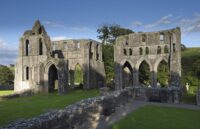![]() Restoration of an effigy in Dundrennan Abbey in Dumfries and Galloway, Scotland, has shone a flashlight on the penumbra of medieval murder mystery. The “Abbot’s Stone” is installed against the west wall of the nave of the abbey’s ruined church. A robed abbot lies recumbent with his crozier diagonal across his body and a dagger plunged into his chest. His feet rest on the small, contorted figure of a disemboweled man, his entrails spilling out through a gash in his abdomen. The effigy is believed to date to the 13th century,
Restoration of an effigy in Dundrennan Abbey in Dumfries and Galloway, Scotland, has shone a flashlight on the penumbra of medieval murder mystery. The “Abbot’s Stone” is installed against the west wall of the nave of the abbey’s ruined church. A robed abbot lies recumbent with his crozier diagonal across his body and a dagger plunged into his chest. His feet rest on the small, contorted figure of a disemboweled man, his entrails spilling out through a gash in his abdomen. The effigy is believed to date to the 13th century,
Mr Cox, formerly of the cultural resources team at Historic Environment Scotland, said: “It seems possible that this memorial commemorates an abbot of Dundrennan who was wounded or assassinated.
“The small figure at his feet likely represents his assailant. The symbolism is rather poignant, the scene depicting the abbot as triumphant over his assailant in perpetuity.”
The carving would originally have covered a tomb chest and is one of number to be recently conserved at the abbey, which sits in a valley around five miles from Kirkcudbright.
The Cistercian abbey at Dundrennan was founded in 1142 by Fergus, Lord of Galloway. It was the first of Scotland’s 13 Cistercian monasteries. The early Gothic church was notable for its three stories and open arcades, an unusual design in Scotland, and considerable remains of it managed to survive the Reformation. There are large sections of the 12th century transepts and early 13th century nave still extant, as are significant portions of the mid-13th century chapter house.
 It was not destroyed during the Scottish Reformation; it was just neglected after it. The monks were evicted in 1560, and in 1587 the abbey was annexed by the Crown. Some of the lands were used to create a lordship for James VI’s groom of the bedchamber in 1606. The buildings were used to house livestock. By the 18th century, the abbey was a wreck and numerous visitors wrote about its dilapidated condition.
It was not destroyed during the Scottish Reformation; it was just neglected after it. The monks were evicted in 1560, and in 1587 the abbey was annexed by the Crown. Some of the lands were used to create a lordship for James VI’s groom of the bedchamber in 1606. The buildings were used to house livestock. By the 18th century, the abbey was a wreck and numerous visitors wrote about its dilapidated condition.
Records from the Abbey’s are sparse, so much so that we don’t even have a complete list of its abbots. There are just a few grave stones, charters and legal documents and none of them refer to a stabbing or disemboweling, alas. One extremely important record has survived: a certain Adam Blacadder is documented as having been appointed commendator (administrator) in 1541, a role he held until his death in 1562.
Adam Blacadder? Perhaps we should be paging Rowan Atkinson, too.
Edith Pargeter is one of the best!
—-
Blackadder: ..Well, not if we lose, Percy. If we lose, I’ll be chopped to pieces. My arms will end up at Essex, my torso in Norfolk, and my genitalia stuck up a tree somewhere in Rutland.
Baldrick: With you at the helm, My Lord, we cannot lose.
Blackadder: Ah, but we won’t, Percy, and I shall prove to all that I am a man!
Percy: But you >are< a man, My Lord.
Blackadder: But how shall it be proved, Percy…?
Percy: Well, they could look up that tree in Rutland.
—-
:hattip:
FROM: (Blackadder Series I, Episode 1 – The Foretelling Full Script)
I smell crossover hit!
I wonder: Could that “flower” next to his head be some kind of family or clan “emblem”, “coat of arms” or anything of that kind?
Apparently, some body was “wounded”, “assassinated” or maybe even “drawn” and quartered, but there is no remaining body connected to this.
Friends,
It is unfortunate that the name Blacadder (or Blackadder and Blacader) will forever be associated with that TV series. It obscures and trivializes an important Scottish family.
The main Blacader family lived near Berwick-on-Tweed, and were prominent Border Reivers (highly organized cattle rustlers and general thieves). After most fell at the Battle of Flodden in 1513, the Homes/Humes erased most Blacader survivors and supporters to gain their lands.
Another Blacadder branch included Glasgow’s first Archbishop, Robert Blacadder (died 1508). Also from this branch was Sir Patrick Blacadder, Provost (mayor) of Glasgow in 1498.
Many others with the Blacadder name have achieved distinction in Scottish society, politics and Britain’s armed forces.
I suggest a search on Wikipedia on the Blacadder name (sorry, but URLs for other sites are not allowed here).
Yours Aye,
Mungo Napier, Laird of Mallard Lodge (SCA) 🦆
Scottish history maven and re-enactor